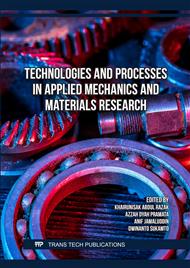[1]
M.P. Groover, Fundamentals of Modern Manufacturing (Materials, Processes, and Systems). Fouth Edition, John Wiley & Sons Inc, 2010.
Google Scholar
[2]
M. Yusuf, S. Bahri and Agustinawati, Design and Fabrication of Portable Tilting Furnace for Aluminium Melting, Int. Jour of Eng., Sci. & Inf. Tech, Vol. 2 (2022) 60-65.
DOI: 10.52088/ijesty.v2i2.250
Google Scholar
[3]
T.S. Piwonka, Aggregate Molding Materials, ASM Handbook, Casting, Volume 15, 1998.
Google Scholar
[4]
M. Yusuf, M.K.A. Ariffin, N. Ismail and S. Sulaiman, Surface Quality and Chip Formation in Turning of LM6 Aluminium Alloy and Particulate Reinforced Metal Matrix Composite, Mat. Sci. For. 773-774 (2014) 894-901.
DOI: 10.4028/www.scientific.net/msf.773-774.894
Google Scholar
[5]
M., Sayuti, R. Putra, and M. Yusuf, The Characterisation of Magnetic Materials Extracted from Aceh Iron Sand, Chem. Ind. & Chem. Eng. Quar. 26 (2020)105−111.
DOI: 10.2298/ciceq190325029s
Google Scholar
[6]
B.V. Omidiji, H.A Owolabi, and D.A. Adetan, Characterization of Southwestern Nigeria River Sand for foundry use, Inter. Jour. of Eng. Sci. 13 (2020) 36-42.
DOI: 10.36224/ijes.130201
Google Scholar
[7]
J.R. Brown, Foseco Foundryman's Handbook, Eleventh Edition, Butterworth Heinman Publishers, Oxford, 1999.
Google Scholar
[8]
American Foundry Society, Testing procedures, Moisture, AFS 2219-00-S, Mold & Core Test Handbook, American Foundry Society, Illinois (2001).
Google Scholar
[9]
American Foundry Society, Testing procedures, Clay, AFS 2110-00-S, Mold & Core Test Handbook, American Foundry Society, Illinois (2001)
Google Scholar
[10]
T.A. Burns, Foseco Foundryman's Handbook, 9th ed, Foseco (F.S.) Ltd. Tamworth Staffordshire Permgamon Press Oxford England, (1986)
Google Scholar
[11]
A.M., Mikhailov, Metal casting. Mir Publishers,1989.
Google Scholar
[12]
S.Z.M. Nor, R. Ismail, and M.I.N. Isa, Preliminary Study on the Potential of East Coast of Peninsular Malaysia's Silica for Foundry: Case Study–Terengganu, Int. Jour. of Mat. and Mech. Eng. 1 (2012) 53-56.
Google Scholar
[13]
A. Abdullah, S. Sulaiman, T.H.T. Baharudin, M.K.A. Ariffin, M.K.A. T.R. Vijayaram, M. Sayuti, Testing for Green Compression Strength and Permeability Properties on the Tailing Sand Samples Gathered from Ex Tin Mines in Perak State, Malaysia, Adv. Mat. Res. 445 (2012) 859-864.
DOI: 10.4028/scientific5/amr.445.859
Google Scholar
[14]
A. Abdullah, S. Sulaiman, T.H.T. Baharudin, M.K.A. Ariffin, M.K.A. T.R. Vijayaram, The Effect of Bentonite Clay on Green Compression Strength for Tailing Sands from Old Tin Mines in Perak State, Malaysia for Making Green Sand Casting Mould, K. Eng. Mat. 471-472 (2011).
DOI: 10.4028/www.scientific.net/kem.471-472.769
Google Scholar
[15]
Y.L.S. Babata, M.B. Nafiu, K.S. Ajao, I.O. Ambali, Z.U. Elakhame, Y.O. Busari, H.K. Ibrahim and N.I. Aremu, Characterization of Belle Natural Moulding Sand for Foundry Applications, J. of Res. Inf. Civ. Eng. 16 (2019) 2657-2678.
Google Scholar
[16]
N.A. Ademoh, A.O. Ibrahim, Determination of the Suitability of River Gurara Bed Sand Bonded with Clay for Foundry Casting Moulds, Ind. Eng. Let. 9 (2019) 43-51.
DOI: 10.7176/iel/9-2-05
Google Scholar
[17]
I.A. Onimisi, Investigation of the Moulding Properties of Gurara River Bed Sand in Niger State Using Kaolin and Bentonite as Binder, Int. Jour. of Sci. & Eng. Res. 9 (2018) 1160-1176.
Google Scholar
[18]
F.O. Edoziuno, O.G. Utu, C.C. Nwaeju, Variation of moisture content with the properties of synthetic moulding sand produced from river Niger sand (Onitsha deposit) and Ukpor Clay, Int. Jour. of Res. in Adv. Eng. and Tech. 2 (2017) 102-106.
DOI: 10.1016/j.rinma.2021.100194
Google Scholar



